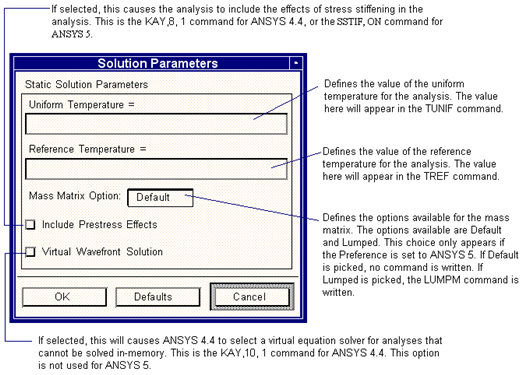

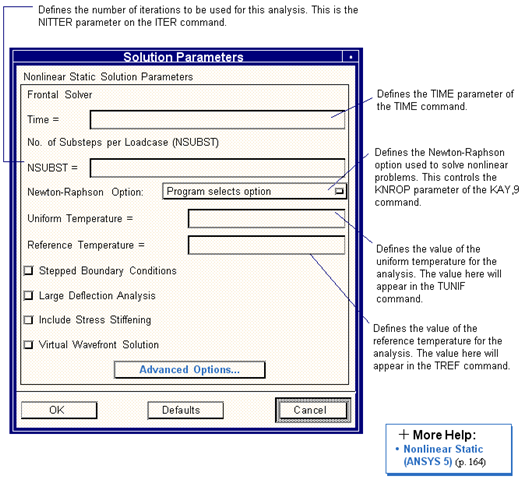
Input Data | Description |
Stepped Boundary Conditions | Causes the analysis to step the boundary conditions rather than ramp them. If selected, this will generate the KBC,1 command. |
Large Deflection Analysis | Causes the analysis to include the large deflection option in the solution. This is the KAY,6, 1 command. |
Include Stress Stiffening | If selected, this causes the analysis to include the effects of stress stiffening in the analysis. This is the KAY,8, 1 command. |
Virtual Wavefront Solution | If selected, this will cause ANSYS 4.4 to select a virtual equation solver for analyses that cannot be solved in-memory. This is the KAY,10, 1 command. |
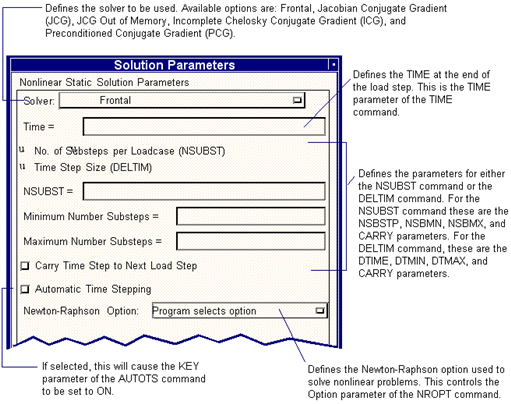
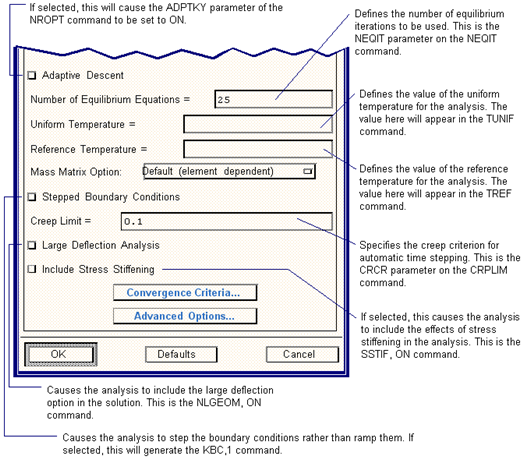
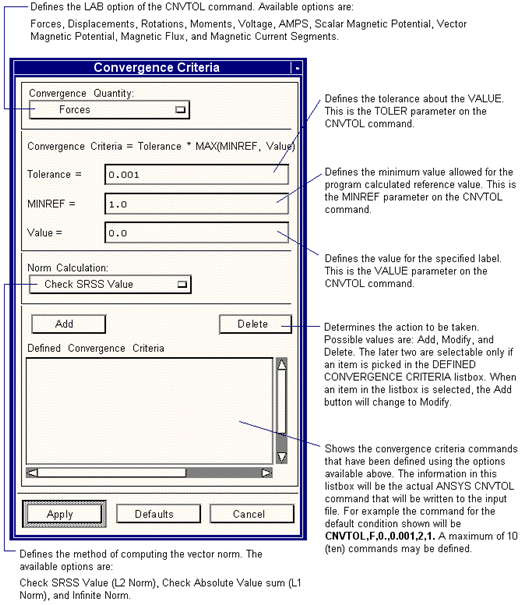
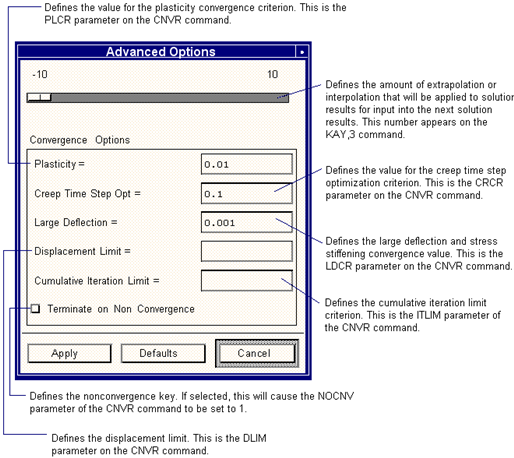

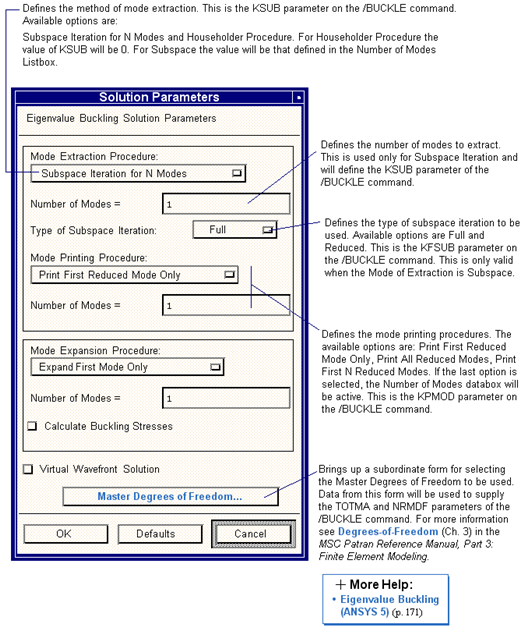
Parameter Name | Description |
Mode Expansion Procedure | Defines the method to use for expanding modes. Available options are: Expand First Mode Only, Expand No Modes and Expand N Modes. If Expand N Modes is selected, the Number of Modes Databox will be active. This is the KEXPM parameter on the ⁄BUCKLE command. |
Number of Modes | This will be active when the Mode Expansion Procedure is set to Expand N Modes. The number entered in this databox will be used as the KEXPM parameter on the /BUCKLE command. |
Calculate Buckling Stresses | If selected, this will cause the KPSTR parameter of the /BUCKLE command to be set to 1. |
Virtual Wavefront Solution | If selected, this will cause ANSYS 4.4A to select a virtual equation solver for analyses that cannot be solved in-memory. This is the KAY,10, 1 command for ANSYS 4.4A. This option is not displayed if the Selected Preference is “ANSYS 5.” |
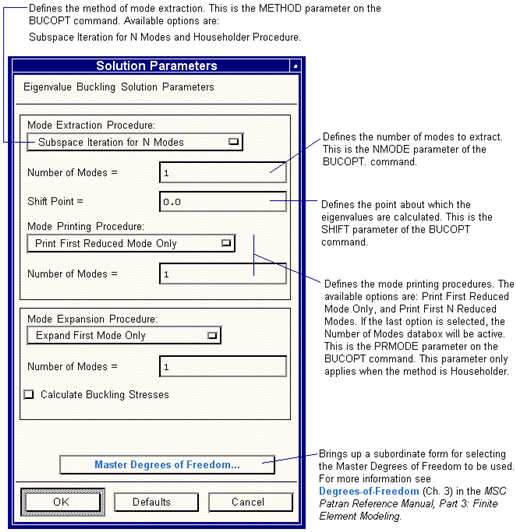
Parameter Name | Description |
Mode Expansion Procedure | Defines the method to use for expanding modes. Available options are: Expand First Mode Only, Expand No Modes and Expand N Modes. If Expand N Modes is selected, the Number of Modes Databox will be active. If Expand No Modes is the selected procedure, no MXPAND command and no EXPASS command will be written. If Expand First Mode Only is selected, the EXPASS, ON command and the MXPAND command will be written with NMODE set to 1. If Expand N Modes is selected, the EXPASS, ON and MXPAND command will be written. The value of NMODE will be set by the data in the Number of Modes databox. |
Number of Modes | Becomes active when the Mode Expansion Procedure is set to Expand N Modes. The number entered in this databox will be used as the NMODE parameter on the MXPAND command. |
Calculate Buckling Stresses | If selected, this will cause the ELCALC parameter of the MXPAND command to be set to “YES.” Otherwise, the ELCALC parameter will be set to “NO.” |

Parameter Name | Description |
Normalize Shapes 12to Unity | Controls the normalization of the mode shapes. If it is selected, the KPMOD parameter of theKAY,3 command will be set to the negative of the value in the Number of Modes to Print databox for ANSYS 4.4. If ANSYS 5 is being used, this will set the Nrmkey parameter of the MODOP command to ON. |
Include Stress Stiffening | If selected, this causes the analysis to include the effects of stress stiffening in the analysis. This is the KAY,8, 1 command for ANSYS 4.4, or the SSTIF, ON command for ANSYS 5. |
Virtual Wavefront Solution | If selected, this will cause ANSYS 4.4A to select a virtual equation solver for analyses that cannot be solved in-memory. This is the KAY,10, 1 command for ANSYS 4.4. This option is not displayed if the Selected Preference is “ANSYS 5.” |
Expansion Parameters | Brings up the subordinate form to allow definition of the parameters that will control the expansion of the modes. See Mode Expansion Parameters. |
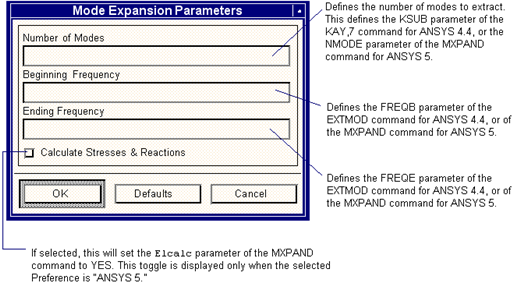
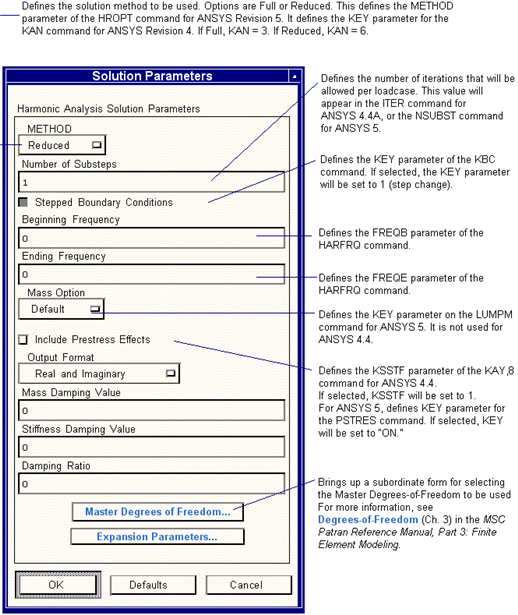
Parameter Name | Description |
Output Format | Defines the KPPHA parameter of the KAY,3 command for ANSYS 4.4 or the REIMKY parameter of the HROUT command for ANSYS 5. Options are Amplitude and Phase, or Real and Imaginary (default). |
Mass Damping Value | Defines the VALUE parameter of the ALPHAD command. |
Stiffness Damping Value | Defines the VALUE parameter of the BETAD command. |
Damping Ratio | Defines the RATIO parameter of the DMPRAT command. |
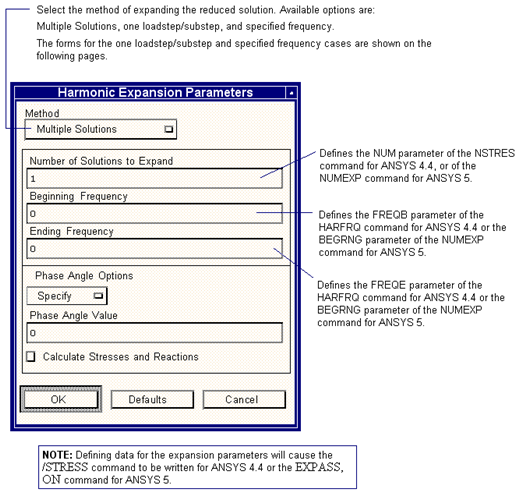
Parameter Name | Description |
Phase Angle Options | Defines the KIMG parameter of the /STRESS command for ANSYS 4.4, or the ANGLE parameter of the HREXP command for ANSYS 5. Available options are All or Specify. If All is selected, KIMG is set to 1 for ANSYS 4.4 or ANGLE is set to “All” for ANSYS 5. |
Phase Angle Value | Defines the PHASE parameter of the HARFRQ command for ANSYS 4.4 or the ANGLE parameter of the HREXP command for ANSYS 5. This databox is presented only if the Phase Angle Options option menu is set to Specify. |
Calculate Stresses and Reactions | Defines the ELCALC parameter of the NUMEXP command for ANSYS 5. It has no effect for ANSYS 4.4. |
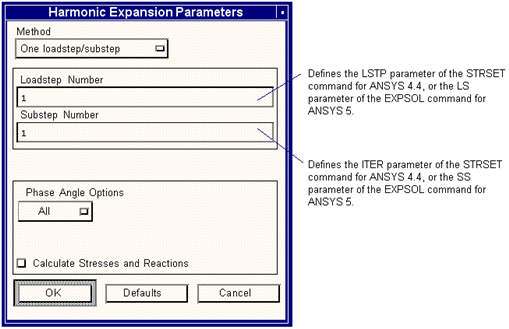
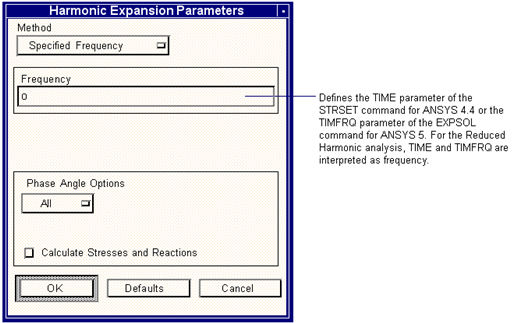
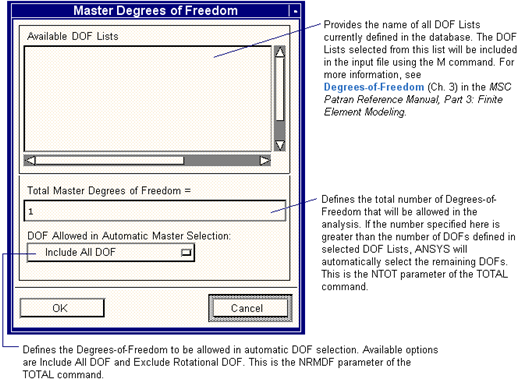
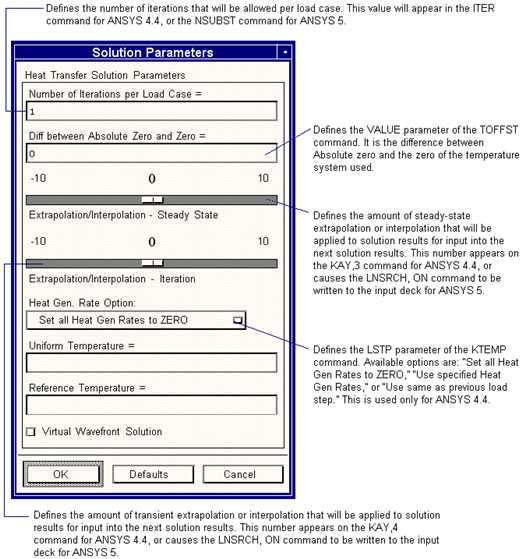
Parameter Name | Description |
Uniform Temperature | Defines the value of the uniform temperature for the analysis. The value here will appear in the TUNIF command. |
Reference Temperature | Defines the value of the reference temperature for the analysis. The value here will appear in the TREF command. |
Virtual Wavefront Solution | If selected, this will cause ANSYS 4. to select a virtual equation solver for analyses that cannot be solved in-memory. This is the KAY,10, 1 command for ANSYS 4.4. This option is not used for ANSYS 5. |